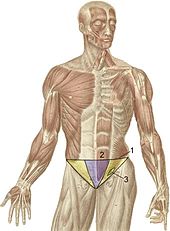Groin region
The groin ( Latin for Inguen ) is the lower (human) or rear (other mammals ) lateral part of the abdominal wall .
In humans, the groin area or inguinal region ( Regio inguinalis ) is bounded upwards by the connecting line between the two upper iliac crests ( Spina iliaca anterior superior ) of the pelvis (so-called Planum interspinale ). In animals, the line connecting the front end of the two hip humps ( tubera coxae ) is defined as the front border. In the caudal direction , the groin region is bounded by the upper (human) or front (animal) edge of the pelvis. Towards the middle, the groin area extends to the lateral contour of the straight abdominal muscle , where it borders on the pubic area ( regio pubica ) located between the two groins .
The inguinal region has a natural weak point with the inguinal canal ( canalis inguinalis ) or its internal access ("inner inguinal ring", annulus inguinalis profundus ). At this point, an inguinal hernia can occur, i.e. the contents of the abdominal cavity protrude through the abdominal wall. Direct hernias occur in the Hesselbach triangle . The inguinal region is supplied with blood vessels via the inguinal branches of the external pudendal artery and the superficial circumflex ilium artery .
In ungulates , the mammary gland is located in the groin and pubic region and is called the udder . In goats there is a specific skin gland to the side, the inguinal pocket .
literature
- Gert-Horst Schumacher: Topographical anatomy of humans. Georg Thieme Verlag, 5th edition, Leipzig 1988, ISBN 3-7404-0091-9 .
- Franz-Viktor Salomon et al. (Ed.): Anatomy for veterinary medicine. Enke-Verlag Stuttgart, 2nd ext. 2008 edition, ISBN 978-3-8304-1075-1 .
